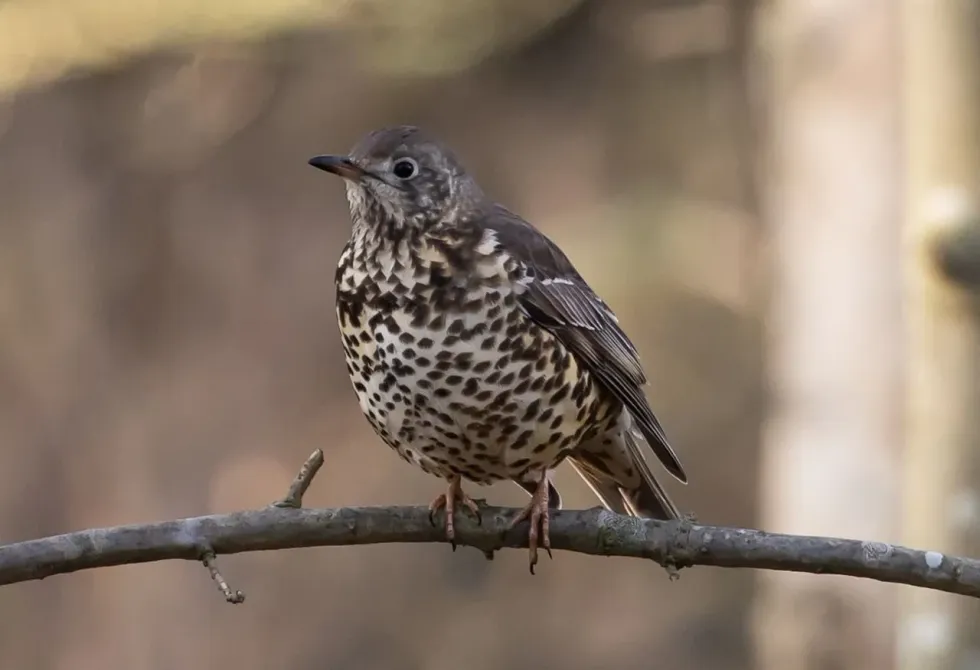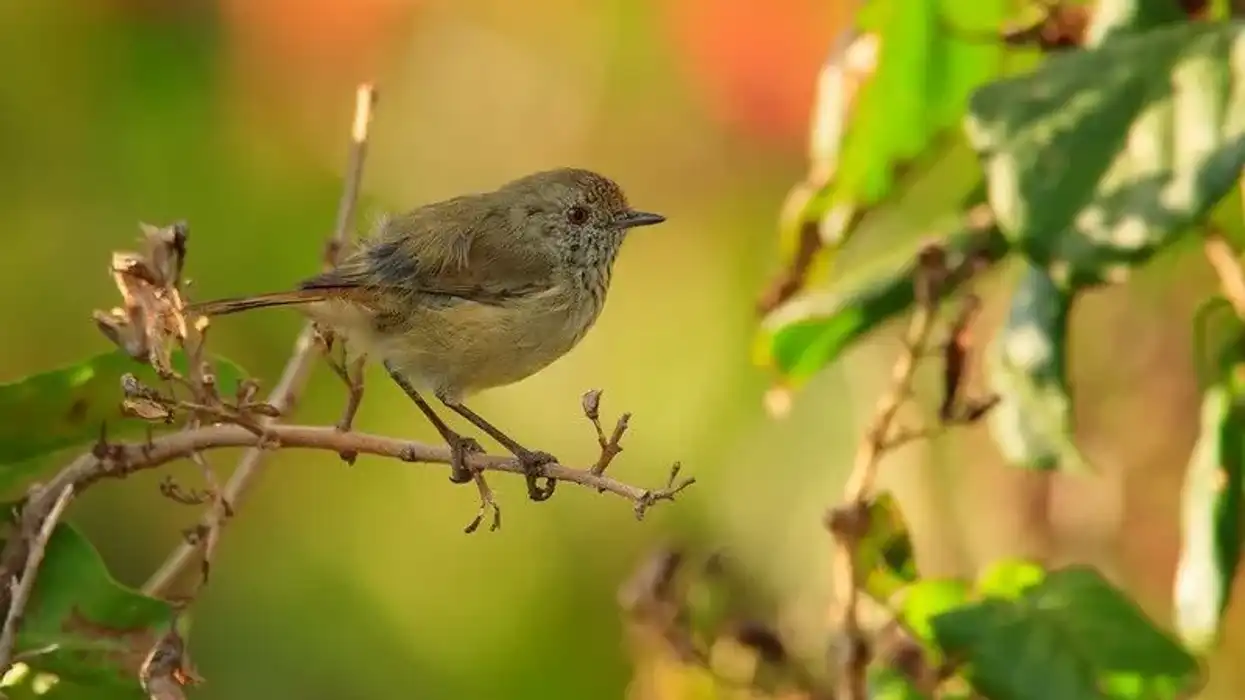The mistle thrush (Turdus viscivorus) is a species of bird that has pale brown-gray upperparts, dark brown eyes, and a long tail that has white tips on the other feathers. Their habitat includes woodlands, grasslands, and parks, and their diet includes insects, fruits, and berries like mistletoe and holly.
They build their nests on the fork on branches of trees or against or tree trunks. It is made up of dry grass, roots, and sticks lined with fine grass and leaves and is made by the female. The mistle thrush isn't rare and is commonly found in the UK.
Let's take a look at these facts and information about mistle thrush, and if you enjoy these, do also read our magpie facts and hermit thrush facts.
Mistle Thrush Interesting Facts
What type of animal is a mistle thrush?
The mistle thrush (Turdus viscivorus) is species of bird.
What class of animal does a mistle thrush belong to?
The mistle thrush belongs to the class Aves, and it is a species of bird found in both Europe and Asia.
How many mistle thrushes are there in the world?
According to the numbers given by the IUCN Red List, the total population of mistle thrush in the world is between 13-30 million.
Where does a mistle thrush live?
Mistle thrush lives in grassland, woodland, gardens, or parks, where food is easily available and where they can get their proper diet. They are migratory birds that migrate towards the south in the winter.
What is a mistle thrush's habitat?
A mistle thrush's habitat includes places like grassland, gardens, parks. These places work as suitable food sources for it and are filled with trees on which they can make their nests. Their habitat is widely spread across Europe, Asia, and North Africa. They migrate towards the south during the winter.
Who do mistle thrushes live with?
They are social birds and often live in pairs. They might even forage in families during summer when plenty of food sources are available.
How long does a mistle thrush live?
Usually, they live for only three years. But, if they have proper care and good food, they may well live up to 21 years. The maximum age recorded for a mistle thrush that lived in Switzerland is 21 years and three months.
How do they reproduce?
These birds are monogamous and remain a pair for the entire year. They acquire a territory that is about 65,340 sq ft (6070.2 sq m) big in size. It is larger in open woodland than in farms. Males defend their territory and attack anyone who enters their breeding area.
Their breeding period begins in February in the West and South of Europe, while in Finland, it starts in early May. There are generally two broods in a year and lays three to five eggs clutch per brood. Males are responsible for feeding the chicks.
What is their conservation status?
Mistle thrushes have the status of Least Concern by the IUCN Red List of Threatened species. Their population is very large, however, it's currently decreasing. According to the IUCN, around 13-30 million birds currently exist in the world.
Mistle Thrush Fun Facts
What do mistle thrushes look like?

Mistle thrushes have pale gray-brown upperparts, while their underparts are off-white. They have yellowish-buff breasts and an off-white belly with a round black spot. They have a long tail that has white tips on outer feathers. Their eyes are also dark brown, and they have black-colored bills. Fieldfares also look like a thrush.
How cute are they?
These small garden birds are really cute and adorable. They get along with humans as they commonly reside in gardens and parks. They might also come to you if you try to feed one in a park.
How do they communicate?
Males sing a melodious song and whistle sound that goes something like 'chewee-trewuu... trureetruuruu', which they use to attract a mate or to warn others that it is their territory. They even use it to maintain a bond with their mate.
In addition, both the genders use a dry chattering 'krrrr' sound, which gets louder when they get alarmed or excited. They also produce a squeaky 'tuk' contact call. They usually sing their songs from treetops.
How big is a mistle thrush?
Mistle thrushes are really small birds that are about 10.6–11 in (27-28 cm) in size. They feed on small insects such as earthworms that are much smaller in size. They are also a bit bigger than the song thrushes, which appear very similar to them.
How fast can a mistle thrush fly?
The flying speed of mistle thrushes has not been measured yet. They are small birds but are quite active and maintain a territory that is about 65,340 sq ft (6070.2 square m) in size, and they use their speed and agility to defend this territory.
How much does a mistle thrush weigh?
Mistle thrushes are lightweight and only weigh about 3.3-5.9 oz (93-167 g). However, despite their small size and light weight, they are quite aggressive when someone tries to intrude on their breeding areas.
What are the male and female names of the species?
The male and the female mistle thrushes do not have any separate names. It is not possible to distinguish between them by looking at them as their plumage does not have a stark difference.
What would you call a baby mistle thrush?
Baby mistle thrushes are called chicks or fledglings. Chicks are similar to an adult but have paler upper portions, and the yellow spots on their underparts are also smaller. By winter, they look more similar to the adult.
What do they eat?
Their diet usually consists of berries and seeds from bushes and trees. They eat insects found in wildlife, while their main food menu includes berries of bushes such as mistletoe, holly, and yew. Chicks are unable to feed themselves when they are born and are fully dependent on their parents for food.
Are they dangerous?
Mistle thrushes live near humans in gardens and parks and build their nests on branches of trees or along the trunk of a tree. They do not attack unnecessarily. Although, they might attack any human, cat, or any other animal that tries to approach their nests.
Would they make a good pet?
Mistle thrushes belong to the thrushes family, and breeders well recommend thrushes to be kept as pets, although people prefer to keep song thrushes. That is because mistle thrushes require much larger cages, and their songs are also a bit shriller.
Did you know...
The mistle thrush scientific name Turdus viscivorus explains the meaning behind its given name. The term 'Turdus' means 'thrush' while 'viscivorus' means 'mistletoe eater'. This bird feeds on mistletoe berries on bushes.
Mistle thrushes have a large population of about 13-30 million and brood twice a year. The breeding period begins in February, and the females lay three to five eggs per clutch and take care of them until they are ready to leave the nest.
Their population distribution is widespread in Europe. They are also found in England, Asia, the Middle East, and South Africa. They migrate towards the south during the winter.
During late summer or autumn, families are seen to roost together. They build their nest on the fork of a branch or by a tree trunk.
They are eaten by cats, snakes, chipmunks, mice, and squirrels.
What is the difference between a song thrush and a mistle thrush?
Mistle thrushes and song thrushes are very similar in appearance. But mistle thrushes are larger than the song thrushes. Their tail is longer and wingspan greater than the song thrush. While mistle thrushes have pale brown-grey upper bodies with dark brown eyes and an off-white belly, song thrushes have a greyer plumage and are less paler than the former.
Song thrushes build their nest in small gardens and parks, while mistle thrushes are less likely to build a nest there and travel to the countryside during autumn or early winter in search of berries.
What does a mistle thrush sound like?
Mistle thrushes like to sing in the early mornings. Singing a 'chewee-trewuutrureetruuruu' call, they attract a mate or warn others of their territory. Both genders use a dry chattering 'krrrr', along with a squeaky 'tuk' sound to contact each other.
Here at Kidadl, we have carefully created lots of interesting family-friendly animal facts for everyone to discover! Learn more about some other birds from our budgerigar facts and harpy eagle facts pages.
You can even occupy yourself at home by coloring in one of our free printable Mistle thrush coloring pages.









